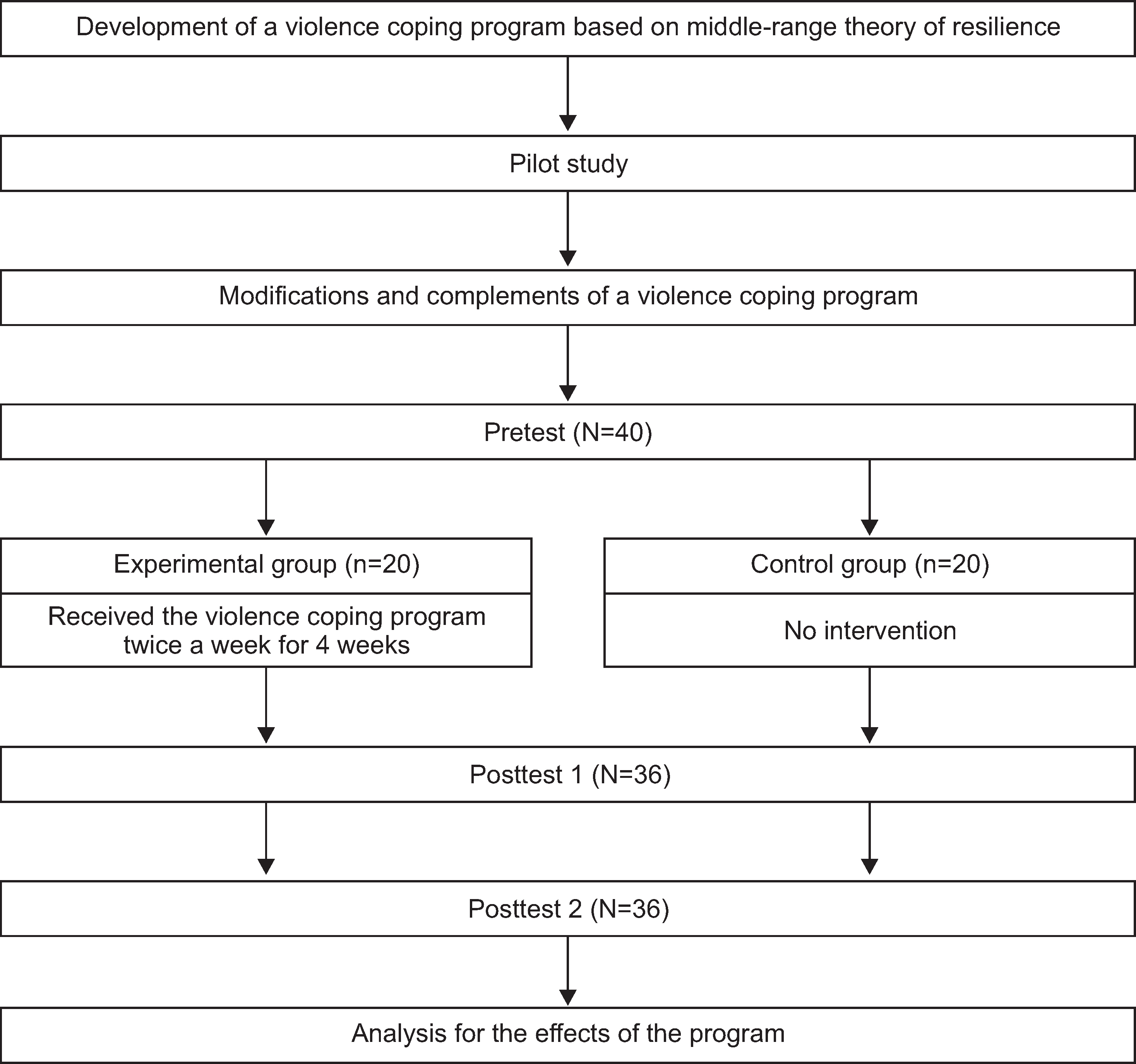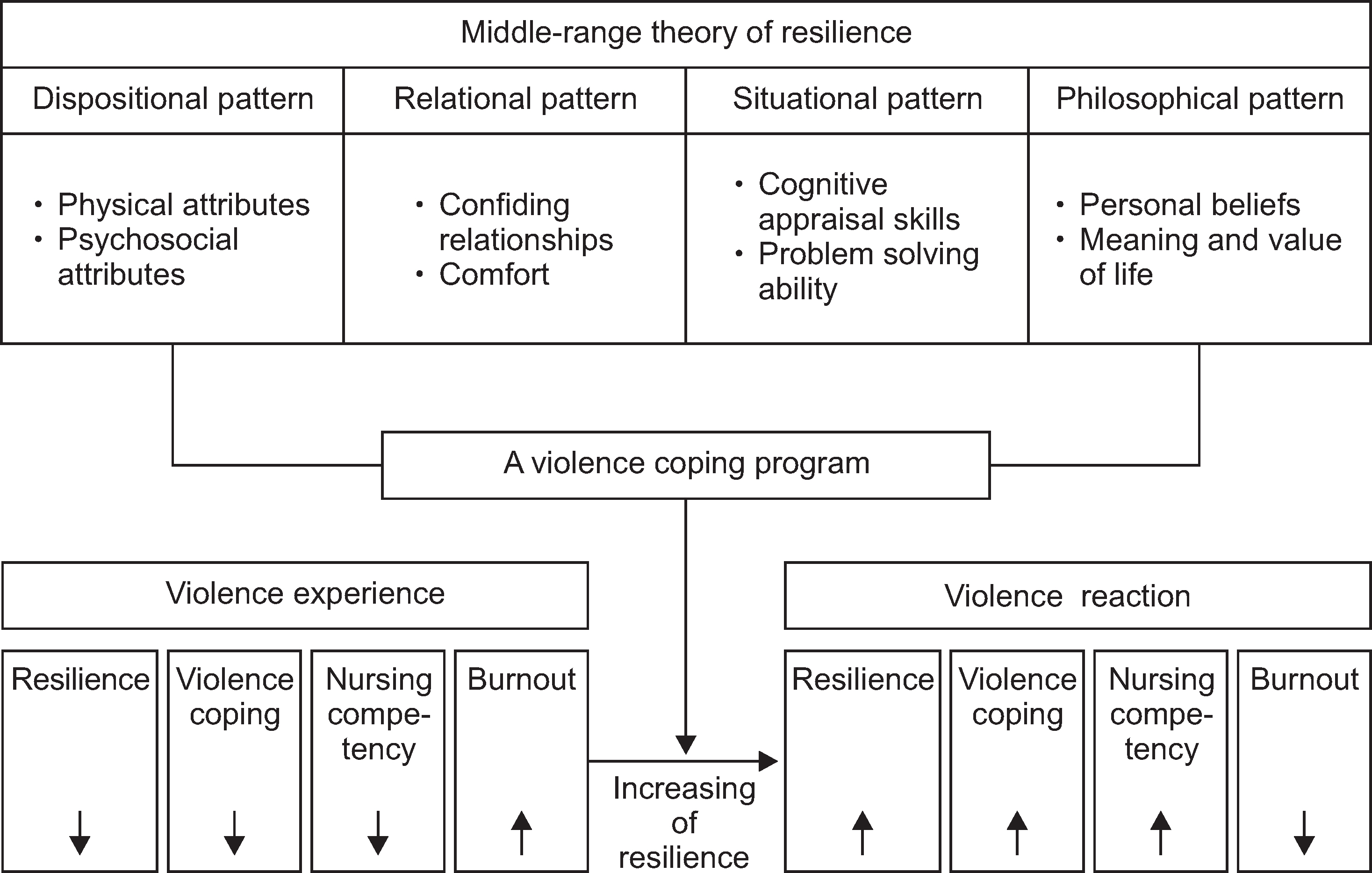J Korean Acad Nurs.
2017 Jun;47(3):332-344. 10.4040/jkan.2017.47.3.332.
The Effects of Violence Coping Program Based on Middle-Range Theory of Resilience on Emergency Room Nurses' Resilience, Violence Coping, Nursing Competency and Burnout
- Affiliations
-
- 1Nursing Department, Masan University, Changwon, Korea.
- 2College of Nursing · Institute of Health Sciences, Gyeongsang National University, Jinju, Korea. sung@gnu.ac.kr
- KMID: 2426463
- DOI: http://doi.org/10.4040/jkan.2017.47.3.332
Abstract
- PURPOSE
The purpose of this study was to examine the effects of a violence coping program (VCP) based on Polk's middle-range theory of resilience on nursing competency, resilience, burnout, and the ability to cope with violence in nurses working in emergency rooms.
METHODS
A quasi-experimental study, with a nonequivalent control group and a pretest-posttest design, was conducted. Participants were 36 nurses who worked in emergency rooms and had experienced violence; 18 nurses from D hospital and 18 nurses from C hospital were assigned to the experimental and control groups, respectively. The experimental group received the VCP twice per week for 8 weeks.
RESULTS
Levels of resilience, F=59.41, p<.001, active coping behavior, χ²=33.09, p<.001, and nursing competency, F=59.41 p<.001, increased significantly and levels of passive coping behavior, χ²=22.92, p<.001, and burnout, F=52.74, p<.001, decreased significantly in the experimental group.
CONCLUSION
The results suggest that the VCP could be an effective strategy for reducing burnout and improving resilience, active coping behavior, and nursing competency. Therefore, it would be a useful intervention for improving the quality of nursing care provided in emergency rooms.
Keyword
MeSH Terms
Figure
Cited by 1 articles
-
Clinical nurses’ experiences of workplace verbal violence: a phenomenological study
Min Soo Woo, Hyoung Suk Kim, Jeung-Im Kim
Korean J Women Health Nurs. 2022;28(2):154-164. doi: 10.4069/kjwhn.2022.05.24.2.
Reference
-
References
1. Park E, Kang SJ, Lee EK, Ji EJ, Kang RH, Paik CH. Violence experience of clinical nurse in the hospital. Journal of Korean Clinical Nursing Research. 2001; 7(2):187–202.2. Kim SY, Eom M, Oh HY, Ahn HY. Violence episodes and responses of emergency room nurses. Journal of Korean Academy of Fundamentals of Nursing. 2007; 14(4):446–456.3. Normandale S, Davies J. Bullying at work. Community Practitioner. 2002; 75:474–477.4. Gorkin M. The four stages of burnout. Journal of Additional information. 2004; 83(4):24–4.5. Yang JH, Jung HY. Relationship between violence response, coping, and burnout among emergency department nurses. Journal of Korean Academy of Fundamentals of Nursing. 2009; 16(1):103–111.6. Sung MH. Relationship of the experience of violence to burnout and job satisfaction in emergency department nurses. Journal of Korean Clinical Nursing Research. 2008; 14(2):83–92.7. Jackson D, Firtko A, Edenborough M. Personal resilience as a strategy for surviving and thriving in the face of workplace adversity: A literature review. Journal of Advanced Nursing. 2007; 60(1):1–9. http://dx.doi.org/10.1111/j.1365-2648.2007.04412.x.
Article8. Tusaie K, Dyer J. Resilience: A historical review of the construct. Holistic Nursing Practice. 2004; 18(1):3–8. quiz 9-10.9. Park MM, Park JW. Development of resilience scale for nurses. Journal of Korean Academy of Fundamentals of Nursing. 2016; 23(1):32–41. http://dx.doi.org/10.7739/jkafn.2016.23.1.32.
Article10. Lee AS, Yoon CK, Park JK. Effects of social support and ego-resilience on nursing performance of hospital nurses. Korean Journal of Occupational Health Nursing. 2012; 21(3):283–289. http://dx.doi.org/10.5807/kjohn.2012.21.3.283.
Article11. Kang HH. Relationship between social capital of sports voucher, ego-resilience, and perception of empowerment of adolescent in the low-status. Korean Journal of Sports Science. 2013; 22(5):491–507.12. Park YJ, Lee EJ. A study on ego-resilience, disaster experience and core competencies among emergency room nurses. Journal of Korean Clinical Nursing Research. 2015; 21(1):67–79. http://dx.doi.org/10.22650/JKCNR.2015.21.1.67.13. Jang KS. A study on establishment of clinical career development model of nurses [dissertation]. Seoul: Yonsei Unversity;2000. p. 1–201.14. Polk LV. Toward a middle-range theory of resilience. ANS Advances in Nursing Science. 1997; 19(3):1–13. http://dx.doi.org/10.1097/00012272-199703000-00002.
Article15. Kim JC, Seol YM, Song HS. Survey of emergency department violence. Journal of the Korean Society of Emergency Medicine. 2003; 14(3):309–313.16. Park JK, You YH, Park JS, Park SS, Chung SP, Kim SW, et al. Current status of violence in the emergency centers: Frequency and management. Journal of the Korean Society of Emergency Medicine. 2004; 15(6):575–579.17. Hyun MS, Cho HJ, Lee MA. Effect of SBAR-collaborative communication program on the nurses’ communication skills and the collaboration between nurses and doctors. Journal of Korean Academy of Nursing Administration. 2016; 22(5):518–530. http://dx.doi.org/10.11111/jkana.2016.22.5.518.
Article18. Waltz CF, Bausell RB. Nursing research: Design, statistics, and computer analysis. Philadelphia, PA: F. A. Davis Co.;1981. p. 39–100.19. Choi WJ, Cho SH, Cho NS, Kim GS. Effect of an education program on violence in the emergency department. Journal of the Korean Society of Emergency Medicine. 2005; 16(2):221–228.20. Lee EO, Lim NY, Park HA. Nursing research and statistics. Paju: Soomoonsa;1998. p. 378–384.21. Kim SJ, Choi MS, Sung KW. Variables affecting competency of nurses in nursing homes. Journal of Korean Gerontological Nursing. 2010; 12(1):29–39.22. Maslach C, Jackson SE. The measurement of experienced burnout. Journal of Organizational Behavior. 1981; 2(2):99–113. http://dx.doi.org/10.1002/job.4030020205.
Article23. Choi HY, Chung NW. Perfectionism tendency, social support, and burnout among counselors. The Korean Journal of Health Psychology. 2003; 8(2):279–300.24. Choi SO, Cho SY. The development and effect analysis of a laughter therapy program to improve the self-esteem and stress-coping skills of children using a community children’s center. Korean Journal of Family Welfare. 2011; 16(4):97–117.25. DiPietro F. Vicarious trauma and compassion fatigue in battered women’s advocates: A secondary prevention program [dissertation]. West Hartford, CT: University of Hartford;2005. p. 1–202.26. McDonald G, Jackson D, Wilkes L, Vickers MH. A work-based educational intervention to support the development of personal resilience in nurses and midwives. Nurse Education Today. 2012; 32(4):378–384. http://dx.doi.org/10.1016/j.nedt.2011.04.012.
Article27. Chang KM. The relations of ego-resiliency, stress coping style, and psychological growth environment. Korean Journal of Youth Studies. 2003; 10(4):143–161.28. Wagnild GM, Young HM. Development and psychometric evaluation of the resilience scale. Journal of Nursing Measurement. 1993; 1(2):165–178.29. Parry SR. The question for competencies. Training and Development Journal. 1996; 33(7):48–56.30. Park HW. The effect of laughter therapy program on mental health. The Korean Journal of Stress Research. 2010; 18(3):287–294.31. Alschuler CF, Alschuler AS. Developing healthy responses to anger: The counselor’s role. Journal of Counseling & Development. 1984; 63(1):26–29.
Article
- Full Text Links
- Actions
-
Cited
- CITED
-
- Close
- Share
- Similar articles
-
- Impact of Response to Violence and Resilience to Burnout in Emergency Department Nurses
- Relationship between Violence Response, Coping, and Burnout among Emergency Department Nurses
- Mediating Effect of Resilience on the Association between Violence Experience and Violence Response among Nurses
- Effects of Hospital-Based Violence-Prevention and Coping Programs on Nurses’ Violence Experience, Violence Responses, Self-Efficacy, and Organizational Commitment
- Factors Influencing Burnout in Emergency Room Nurses



